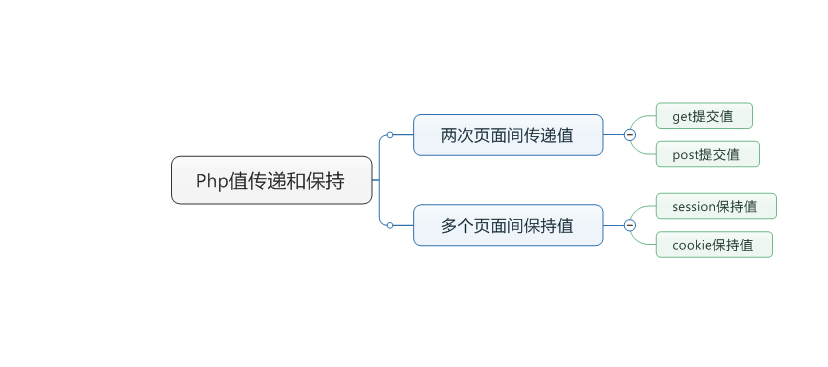1. Directory structure

2. Transferring values between two pages
To transfer a small amount of data between two pages, you can use get submission or post submission. The difference between the two will not be described in detail.
1. Get submission
Use get submission to transfer data, and modify the URL sent to the server in the link address as shown below http://www.cnblogs.com/MarkRao/p/php01.html?gName= mark&gAge=26, of course, you can also set method="get" in the form, receive the data value submitted by get in php, and use the predefined $_GET variable
The information sent from the form with the GET method is available to anyone They are all visible (displayed in the browser's address bar), and there are limits on the amount of information sent.
<html> <head> <meta charset="utf-8"> <title>get提交值</title> </head> <body> <form action="getPage.php" method="get"> 名字: <input type="text" name="gName"> 年龄: <input type="text" name="gAge"> <input type="submit" value="提交"> </form> </body> </html>
The "getPage.php" file can now collect form data through the $_GET variable (please note that the name of the form field will automatically become the key in the $_GET array):
1 欢迎 <?php echo $_GET["gName"]; ?>!<br> 2 你的年龄是 <?php echo $_GET["gAge"]; ?> 岁。
2. Post submission
Use post submission to transfer data, set method="post" in the form, receive the data value submitted by post in php, use the predefined $_POST variable
The information sent from the form with the POST method is available to everyone It's invisible (doesn't show up in the browser's address bar), and there's no limit on the amount of information sent.
Note: However, by default, the maximum amount of information sent by the POST method is 8 MB (can be changed by setting post_max_size in the php.ini file).
<html> <head> <meta charset="utf-8"> <title>post提交值</title> </head> <body> <form action="postPage.php" method="post"> 名字: <input type="text" name="pName"> 年龄: <input type="text" name="pAge"> <input type="submit" value="提交"> </form> </body> </html>
The "postPage.php" file can now collect form data through the $_POST variable (please note that the name of the form field will automatically become the key in the $_POST array):
欢迎 <?php echo $_POST["pName"]; ?>!<br> 你的年龄是 <?php echo $_POST["pAge"]; ?> 岁。
3. Maintain between multiple pages Value
To maintain data between multiple pages, you can use session to save it or you can use cookie to save it. The difference between the two will not be described in detail.
1. Session save data
PHP session variables are used to store information about the user session (session), or change the settings of the user session (session). Session variables store information for a single user and are available to all pages in the application. The working mechanism of Session is to create a unique ID (UID) for each visitor and store variables based on this UID. The UID is stored in a cookie or passed through the URL.
Before you can store user information in a PHP session, you must first start the session.
Note: The session_start() function must be located before the tag:
The correct way to store and retrieve session variables is to use PHP’s $_SESSION variable:
<?php session_start(); // 存储 session 数据 $_SESSION['viewCount']=1; ?> <html> <head> <meta charset="utf-8"> <title>session保持数据值</title> </head> <body> <?php // 取出 session 数据 echo "浏览量:". $_SESSION['viewCount']; ?> </body> </html>
2. Cookies save data
Cookies Commonly used to identify users. A cookie is a small file that a server leaves on a user's computer. Each time the same computer requests a page through the browser, the cookie will be sent to the computer. With PHP, you can create and retrieve cookie values.
The setcookie() function is used to set cookies.
Note: The setcookie() function must be located before the tag.
The syntax is as follows
//name存储的键名 //value存储的键值 //expire存储的超时时间 //path存储的位置 //domain存储区别的域名 setcookie(name, value, expire, path, domain);
The $_COOKIE variable is used to retrieve the value of the cookie.
<?php // 输出 cookie 值 echo $_COOKIE["user"]; // 查看所有 cookie print_r($_COOKIE); ?>
When deleting cookies, you should change the expiration date to a point in time in the past:
<?php
// 设置 cookie 过期时间为过去 1 小时
setcookie("user", "", time()-3600);
?>The above is the method that the editor introduces to you on how to pass values and maintain values between PHP pages. I hope it will be helpful to everyone. . I would also like to thank you all for your support of the PHP Chinese website!
For more related articles on methods of transferring values and maintaining values between PHP pages, please pay attention to the PHP Chinese website!




